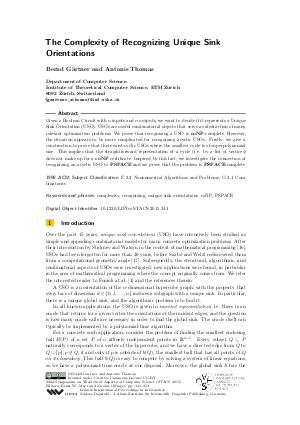The Complexity of Recognizing Unique Sink Orientations
Authors Bernd Gärtner, Antonis Thomas
-
Part of:
Volume:
32nd International Symposium on Theoretical Aspects of Computer Science (STACS 2015)
Part of: Series: Leibniz International Proceedings in Informatics (LIPIcs)
Part of: Conference: Symposium on Theoretical Aspects of Computer Science (STACS) - License:
 Creative Commons Attribution 3.0 Unported license
Creative Commons Attribution 3.0 Unported license
- Publication Date: 2015-02-26
File

PDF
LIPIcs.STACS.2015.341.pdf
- Filesize: 0.67 MB
- 13 pages
Document Identifiers
Subject Classification
Keywords
- complexity
- recognizing
- unique sink orientations
- coNP
- PSPACE
Metrics
- Access Statistics
-
Total Accesses (updated on a weekly basis)
0Document
0Metadata
Abstract
Given a Boolean Circuit with n inputs and n outputs, we want to decide if it represents a Unique Sink Orientation (USO). USOs are useful combinatorial objects that serve as abstraction of many relevant optimization problems. We prove that recognizing a USO is coNP-complete. However, the situation appears to be more complicated for recognizing acyclic USOs. Firstly, we give a construction to prove that there exist cyclic USOs where the smallest cycle is of superpolynomial size. This implies that the straightforward representation of a cycle (i.e. by a list of vertices) does not make up for a coNP certificate. Inspired by this fact, we investigate the connection of recognizing an acyclic USO to PSPACE and we prove that the problem is PSPACE-complete.
Cite As Get BibTex
Bernd Gärtner and Antonis Thomas. The Complexity of Recognizing Unique Sink Orientations. In 32nd International Symposium on Theoretical Aspects of Computer Science (STACS 2015). Leibniz International Proceedings in Informatics (LIPIcs), Volume 30, pp. 341-353, Schloss Dagstuhl – Leibniz-Zentrum für Informatik (2015)
https://doi.org/10.4230/LIPIcs.STACS.2015.341
BibTex
@InProceedings{gartner_et_al:LIPIcs.STACS.2015.341,
author = {G\"{a}rtner, Bernd and Thomas, Antonis},
title = {{The Complexity of Recognizing Unique Sink Orientations}},
booktitle = {32nd International Symposium on Theoretical Aspects of Computer Science (STACS 2015)},
pages = {341--353},
series = {Leibniz International Proceedings in Informatics (LIPIcs)},
ISBN = {978-3-939897-78-1},
ISSN = {1868-8969},
year = {2015},
volume = {30},
editor = {Mayr, Ernst W. and Ollinger, Nicolas},
publisher = {Schloss Dagstuhl -- Leibniz-Zentrum f{\"u}r Informatik},
address = {Dagstuhl, Germany},
URL = {https://drops.dagstuhl.de/entities/document/10.4230/LIPIcs.STACS.2015.341},
URN = {urn:nbn:de:0030-drops-49252},
doi = {10.4230/LIPIcs.STACS.2015.341},
annote = {Keywords: complexity, recognizing, unique sink orientations, coNP, PSPACE}
}
Author Details
References
-
José L. Balcázar, Antoni Lozano, and Jacobo Torán. The complexity of algorithmic problems on succinct instances. In Ricardo Baeza-Yates and Udi Manber, editors, Computer Science, pages 351-377. Springer US, 1992.

-
Gregory E. Coxson. The P-matrix problem is co-NP-complete. Mathematical Programming, 64(1-3):173-178, 1994.

-
Kaspar Fischer and Bernd Gärtner. The smallest enclosing ball of balls: combinatorial structure and algorithms. Internat. J. Comput. Geom. Appl., 14(4-5):341-378, 2004.

-
Jan Foniok, Bernd Gärtner, Lorenz Klaus, and Markus Sprecher. Counting Unique-Sink Orientations. Discrete Applied Mathematics, 163, Part 2:155-164, 2014.

-
Hana Galperin and Avi Wigderson. Succinct representations of graphs. Information and Control, 56(3):183-198, 1983.

-
Bernd Gärtner. The Random-Facet simplex algorithm on combinatorial cubes. Random Structures & Algorithms, 20(3):353-381, 2002.

-
Bernd Gärtner and Leo Rüst. Simple stochastic games and P-matrix generalized linear complementarity problems. In Maciej Liskiewicz and Rüdiger Reischuk, editors, Proceedings of the 15th International Symposium on Fundamentals of Computation Theory (FCT'05), volume 3623 of Lecture Notes in Computer Science, pages 209-220. Springer, 2005.

-
Bernd Gärtner and Ingo Schurr. Linear Programming and Unique Sink Orientations. In Proc. 17th Annual ACM-SIAM Symposium on Discrete Algorithms (SODA), pages 749-757, 2006.

-
Peter L. Hammer, Bruno Simeone, Thomas M. Liebling, and Dominique de Werra. From linear separability to unimodality: A hierarchy of pseudo-Boolean functions. SIAM J. Discrete Math., 1(2):174-184, 1988.

-
Richard E. Ladner. The circuit value problem is log space complete for P. SIGACT News, 7(1):18-20, 1975.

-
Nancy Lynch. Log space recognition and translation of parenthesis languages. J. ACM, 24(4):583-590, 1977.

-
Jiří Matoušek. The number of Unique-Sink Orientations of the hypercube*. Combinatorica, 26(1):91-99, 2006.

-
Christos H. Papadimitriou and Mihalis Yannakakis. A note on succinct representations of graphs. Information and Control, 71(3):181-185, 1986.

-
Walter J. Savitch. Relationships between nondeterministic and deterministic tape complexities. J. Comput. Syst. Sci., 4(2):177-192, 1970.

-
Ingo Schurr and Tibor Szabó. Finding the sink takes some time: An almost quadratic lower bound for finding the sink of unique sink oriented cubes. Discrete & Computational Geometry, 31(4):627-642, 2004.

-
Alan Stickney and Layne Watson. Digraph models of Bard-type algorithms for the linear complementarity problem. Math. Oper. Res., 3(4):322-333, 1978.

-
Tibor Szabó and Emo Welzl. Unique Sink Orientations of cubes. In Proceedings of the 42nd IEEE Symposium on Foundations of Computer Science (FOCS'01), pages 547-555, 2001.

-
Stefano Tessaro. Randomized algorithms to locate the sink in low dimensional Unique Sink Orientations of cubes. Semester thesis, Computer Science Department, ETH Zürich, 2004.

-
Kathy Williamson-Hoke. Completely unimodal numberings of a simple polytope. Discrete Applied Mathematics, 20(1):69-81, 1988.

